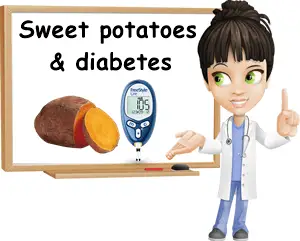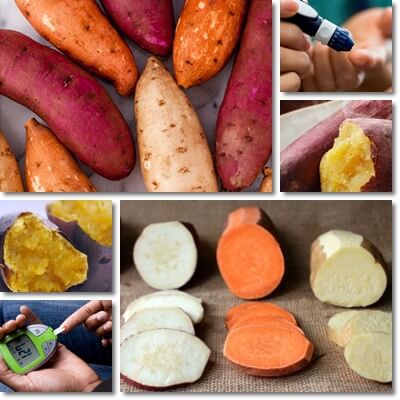Yes, diabetics can eat sweet potatoes in limited amounts as part of an overall balanced and varied diet tailored to their individual nutritional requirements and the restrictions of their condition. As a plant food, sweet potatoes are a significant source of carbohydrates which contribute to blood glucose (sugar) levels. Fortunately, if intake is kept low enough, the effects on blood glucose metabolism are not too pronounced. But while it’s okay to eat small amounts with the condition, it’s important to understand sweet potatoes don’t cure diabetes or lower blood glucose levels by themselves or in combination with other foods.
Sweet potato nutrition facts most relevant for diabetes are total carbohydrate and sugar content, fiber content, glycemic index and glycemic load values. These are the basic nutritional aspects a diabetic person must consider in order to be able to determine if and how much of the tuberous vegetable they can eat. All of these values are not meant to be considered individually, but rather collectively in order to accurately determine the effects of sweet potatoes on blood glucose metabolism and diabetes. Also, variety, intake and choice of cooking method and accompanying foods will influence the nutritional value of the tuberous vegetable and further impact how it affects diabetics.

How much sugar in a sweet potato?
How much sugar does a sweet potato have? Depending on the variety, 100 g of raw sweet potato may have 4.2,4.5, 5.4, 6.14 or over 7 g of simple sugars. The average sweet potato has an estimated 4-5 g of simple sugars per 100 g. The same amount but boiled has approximately 5.74 g of simple sugars, while baking can up content to 6.5 and up to 9.7 g of sugar per 100 g, if not more. Different varieties and different cooking methods will generate a different sugar concentration.
How many carbs in a sweet potato?
But sugar is only part of the total carbohydrate content. 100 g of sweet potatoes provides an average of 20 g of carbohydrates of which 4-5 g are simple sugars and about 3 g indigestible dietary fiber. Sugar and fiber excluded, that leaves about 12 g of digestible carbohydrates, mostly starches, which are also converted in sugar during digestion and contribute to blood glucose levels.
For a diabetic, this is a significant carbohydrate content, one that will generate a rapid increase in blood glucose levels (if the sweet potato is eaten separately from other foods). The more you eat, the more significant the rise in blood glucose levels and the more likely the side effects. Similarly, the more frequently you eat sweet potatoes with diabetes, even in moderate amounts, the more likely the side effects. Eating the potato skin adds important amounts of fiber to a diabetic patient’s diet and helps temper the rise in blood glucose levels.

What is the glycemic index of sweet potatoes?
Total carbohydrate content and choice of cooking method dictate glycemic index and load.
The glycemic index (GI) is a scale that measures how fast the carbohydrates in a plant food raise blood glucose levels (the carbohydrates are broken down during digestion into simple sugar and absorbed into the bloodstream). Below 55 is a low GI. Between 55-69 is a moderate GI. Between 70-100 is a high GI. Raw sweet potatoes glycemic index is 70, making them a high glycemic food.
What is the glycemic load of sweet potatoes?
The glycemic load (GL) is a scale that measures how fast the carbohydrates in a serving of a plant food raise blood glucose levels. Below 10 is a low GL. Between 11-19 is a moderate GL. Over 20 is a high GL. The formula for determining the glycemic load of foods is: glycemic index divided by 100, times carbohydrates in a serving.
For example, 150 g of raw sweet potatoes has a GL of 21 because 70/100 X 30 = 21 (high).
One medium sweet potato at 151 g, boiled, has a GL of 70/100 X 26.7 = 18.7 (moderate).
One medium sweet potato at 150 g, baked, has a GL of 70/100 X 35.1 = 24.57 (high).
But, not all varieties have the same carbohydrate content; the higher the carbohydrate content, the higher the glycemic index and load. Not to mention that changing the cooking method also alters the digestibility of the carbohydrates. For example, boiling gelatinizes the starches which allows for a slower absorption of the carbohydrates in sweet potatoes, so a lower glycemic index and load.
But baking lowers moisture content and essentially concentrates carbohydrates and sugars, rising glycemic index and load values for sweet potatoes. The longer the baking time, the more pregnant the effects. Pureeing the cooked potatoes makes them more susceptible to digestive enzymes (somewhat like pre-digesting them) so you both digest and absorb the carbohydrates in the potatoes faster, resulting in quicker rises in blood glucose levels.
Are sweet potatoes high glycemic or low glycemic?
Both, actually. Depending on intake, variety which determines carbohydrate content, cooking method and cooking time, glycemic index and load values range from low (GI below 50) to moderate (GI 70 and GL 11) to high (GI over 90 and GL over 30). The glycemic index and load values of sweet potatoes are not very reliable and diabetics are advised to count carbohydrate content and plan their meals according to it rather than GI and GL.
Despite being recommended as a good food to eat if you are diabetic, sweet potatoes are not necessarily the best potatoes for diabetes. Yes, they are somewhat better than regular potatoes, but still provide a significant carbohydrate and sugar content and are not that good of a food choice, at least not by themselves.
See also: Can You Eat Sweet Potato Skin?
Tips to reduce effects on blood sugar
Here are 7 great tips to limit the effects of sweet potatoes on blood sugar metabolism:
1) Eat small servings (example: 100-150 g), no more than one serving a day.
2) Spread your intake (serving) throughout the entire day.
3) Don’t eat sweet potatoes every day. Have some variety.
4) Boiling is better than baking. Cubes or whole potatoes are better than puree.
5) Let the cooked potatoes chill, even for one day, then eat them. It makes them low(er) glycemic.
6) Pair with a source of animal protein such as eggs, cheese or meat to really bring glycemic index and load values down and limit effects on blood sugar levels.
7) Plan your meals ahead, count your carbohydrates and determine your serving size. Meal planning, carbohydrate counting, limiting serving size are the best ways to manage your diabetes through diet.
Health benefits
How is sweet potato good for diabetics? The benefits of eating small amounts of the tuberous vegetable include:
1) Benefits for skin thanks to a rich content of beta-carotene (vitamin A precursor) in orange varieties and vitamins B1, B2, B3 and B6 in all varieties.
2) Minor benefits for wound healing thanks to vitamins A, C and E (baking appears to increase vitamin C content).
3) Good for diabetes-associated nerve damage thanks to generous amounts of vitamins B1, B2, B3, B6.
4) Good for eyesight as a result of a rich beta-carotene content in orange-fleshed sweet potato varieties.
5) Minor benefits for diabetes-associated hypertension thanks to good potassium and magnesium content which lower high blood pressure.
6) Good for weight loss and weight management and transit regularity thanks to fiber in the flesh and skin (3 g of fiber per 100 g of potatoes).
7) Hypoglycemic effects from dietary fiber which slows down the absorption of sugar from carbohydrates.
8) Antioxidant, anti-inflammatory effects from vitamins, minerals and antioxidants (beta-carotene in orange varieties, anthocyanins in red and purple varieties).
Good to know: Beta-carotene is a pigmented antioxidant and precursor of vitamin A. But in order to be turned into vitamin A, it requires fat from plant or animal foods. So if you’re eating sweet potatoes, it may help to add a little fat to them, whether it’s a piece of cheese, some oil or meat.
Conclusion
You can eat sweet potatoes safely with diabetes if you limit intake to small amounts, preferably not everyday. If you have diabetes type 1 or type 2, you need to count your carbohydrate intake per day and per meal and plan your meal ahead for when you want to introduce significant sources of carbohydrates such as sweet potatoes. Remember that although the root vegetable can be well tolerated in a diabetic diet under the right conditions, it does not constitute a treatment for diabetes.
